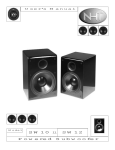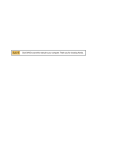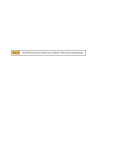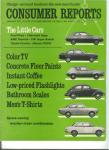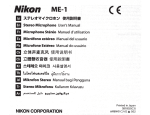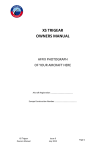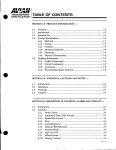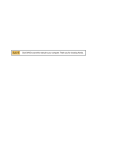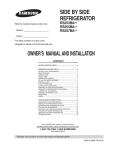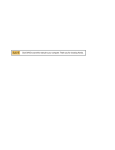Download Honda G100 User's Manual
Transcript
Click SAVE to save this manual to your computer. Thank you for choosing Honda. ENGINES' OWNER'S MANUAL GlOO The engine exhaust from this roduct contains chemicals known toe tState of Cahfornla to cause cancer,blrth defects or other reproductwe harm. R I 31260623 00x31-ZGO-6230 I 1 K2 0 Honda Motor Co., LTd. 2000 @ @ 1200.2000. I 11 @@PRINTED IN JAPAN INTRODUCTION Thank you for purchasing a Honda engine. We want to help youto get the to operate it safely. This manual best results from your new engine and contains information on how to do that; please read it carefully before operating the engine. If a problem should arise,if or you have any questions about your engine, consult an authorized Honda servicing dealer. All information in this publication is based on the latest product information available at the timeof printing. Illustrations are based on the GIOOQA to make changes at any model. Honda Motor Co., Ltd. reserves the right time without notice and without incurring any obligation. No part of this publication maybe reproduced without written permission. This manual shouldbe considered a permanent part of the engine and should remain with the engine if resold. SAFETY MESSAGES Your safety and the safety of others is very important. We have provided important safety messages in this manual and on the engine. Please read these messages carefully. A safety message alerts you to potential hazards that could hurt you or A and others. Each safety messageis preceded by a safety alert symbol one of three signal words: DANGER, WARNING, or CAUTION. These signal words mean: You CAN be KILLED or SERIOUSLY HURT if you don’t follow instructions. You CAN be HURTif you don’t follow instructions. Each message tells you what the hazard is, what can happen, and what you can doto avoid or reduce injury. 2 DAMAGE PREVENTION MESSAGES You will also see other important messages that are preceded by the word NOTICE. This word means: 1- Your engine or other property can be damage if you don’t follow instructions. The purpose of these messages is to help prevent damageto your engine, other property, or the environment. SAFETY INFORMATION 0 0 0 Understand the operation ofall controls and learn how to stop the engine quickly in case of emergency. Make sure the operator receives adequate instruction before operating the equipment. Your engine’s exhaust contains poisonous carbon monoxide. Do not run the engine without adequate ventilation, and never run the engine indoors. The engine and exhaust become very hot during operation. Keep the engine at least 1 meter (3 feet) away from buildings and other equipment during operation. Keep flammable materials away, and do not place anything on the engine while it is running. 3 COMPONENT & CONTROL LOCATION CHOKE LEVER \ FUEL VALVE AIR FUEL FILLER CAP SPARK PLUG MUFFLER OIL FILLER CAP OIL DRAIN PLUG 4 BEFORE OPERATION CHECKS IS YOUR ENGINE READY TO GO? For your safety, andto maximize the servicelife of your equipment,it is very important to take a few moments before you operate the engine to of any problem youfind, or have check its condition. Be sure to take care your servicing dealer correctit, before you operate the engine. Improperly maintaining this engine,or failure to correct a problem before operation, can causea malfunction in which you can be seriously hurt or killed. Always perform a preoperation inspection before each operation, and correct any problem. Before beginning your preoperation checks, be sure the engine is level and the engine switch is theOFF position. Always check the following items before you start the engine: 1. Fuel level (see page 13). 2. Oil level (see page 14). 3. Air cleaner (see page 16). 4. General inspection: Check for fluid leaks and loose or damaged parts. 5. Check the equipment powered by this engine. Review the instructions provided with the equipment powered by this engine for any precautions and procedures that should be followed before engine startup. 5 OPERATION SAFE OPERATING PRECAUTIONS Before operating the engine for the first time, please reviewSAFETY the INFORMATION section on page 3 and the BEFORE OPERATION CHECKS section on page5. Carbon monoxide gasis toxic. unconsciousness and evenkill you. Avoid any areasor actions that expose you to carbon monoxide. Review the instructions provided with the equipment powered by this engine for any safety precautions that should be observed with engine startup, shutdown, or operation. STARTING THE ENGINE FUEL VALV 1. Turn the fuel valve to the ON position. ON 2. Turn the engine switch to the ON position. 6 Move the throttle lever down slightly. THROTTLE LEVER FOR STARTINGA COLD ENGINE: Move the choke lever to CLOSE position. CHOKE LEVER FOR RESTARTINGA WARM ENGINE: Do not use the chokewhen the engine is warmor the air temperature is high. Pull the starter grip lightly until resistance is felt, then pull briskly. I NOTICE I STARTER GRIP Do not allow the starter grip to snap back against the engine. Return it gently to preventdamage to the starter. 7 7. If the choke was usedto start the engine, move the choke leverto the open position as soonas the engine warms up enough to run smoothly without useof the choke. CHOKE LEVER OPEN SETTING ENGINE SPEED Position the throttle lever for the desired engine speed. Some engine applications use are remotely-mounted throttle control rather than the engine-mounted throttle lever mown here. For engine speed recommendations, refer to the instructions provided with the equipment powered by this engine. THROTTLE LEVER 8 STOPPING THE ENGINE To stop the engine in an emergency, turn the engine switch to theOFF position. Under normal conditions, use the following procedure. 1. Move the throttle lever up fully. Some engine applications use remotely-mounted throttle control rather than the enginemounted throttle lever snown here. THROTTLE LEVER 2. Turn the engine switch to the OFF position. GlNE SWITCH 3. Turn the fuel valveto the OFF position. FUEL VALVE 9 y SERVICING YOUR HONDA ENGINE THE IMPORTANCEOF MAINTENANCE Good maintenanceis essential for safe, economical and trouble-free operation. It will also help reduce pollution. before operation, can causea malfunction in which you can beseriously hurt orkilled. Always follow the inspection and maintenance To help you properly care for your engine, the following pages include a maintenance schedule, routine inspection procedures, and simple tools. Other service tasks that maintenance procedures using basic hand tools, are best handledby professionare more difficult, or require special als and are normally performedby a Honda technician or other qualified mechanic. The maintenance schedule applies to normal operating conditions.If you operate your engine under severe conditions, such as sustained high-load or high-temperature operation, or use in unusually wet or dusty conditions, to your consult your servicing dealer for recommendations applicable individual needs and use. Maintenance, replacement, or repair of the emission control devices and systems may be performed by any engine repair establishment or individual, using parts that are “certified” EPA to standards. 10 MAINTENANCE SAFETY Some of the most important safety precautions follow. However, we canno warn you of every conceivable hazard that can arise in performing maintenance. Only you can decide whether or not you should perform a given task. Failure to properly follow maintenance instructions and precautions can cause youto be seriously hurt or killed. Always follow the procedures and precautions in this owner’s manual. SAFETY PRECAUTIONS Make sure the engineis off before you begin any maintenance or repairs. Thiswill eliminate several potential hazards: - Carbon monoxide poisoning from engine exhaust. Be sure thereis adequate ventilation whenever you operate the engine. Burns from hot parts. Let the engine and exhaust system cool before touching. Injury from moving parts. Do not run the engine unless instructed to do so. Read the instructions before you begin, and make sure you have the tools and skills required. To reduce.the possibility offire or explosion, be careful when working around gasoline. Use onlya nonflammable solvent, not gasoline, to clean parts. Keep cigarettes, sparks and flames away from all fuel related parts. Remember that an authorized Honda servicing dealer knows your engine best and is fully equippedto maintain and repairit. To ensure the best quality and reliability, use only new genuine Honda parts or their equivalents for repair and replacement. 11 MAINTENANCE SCHEDULE REGULAR SERVICE PERIOD (3) \\ , I Perform at every indicated month or Before months month operating hour interval whichever each comes first. use 20hrs 50 hrs ITEM U oilEngine Checklevel Chanoe I hrs loo h rs 14 0 15 - 10 Check Air cleaner Clean Spark Check-readjust plug 16 I 17 Replace 19 20 - Clean Sediment cup I SDark Clean arrester Check-adiust speed Idle Combustion chamber Clean Valve Clearance Adjust Fuel tank line 0: I 8 filter Clean Fuel (Every 1 year year or I I O(2) Every years (Replaceif necessary) (2) Emission related items (1) Service more frequently when used in dusty areas. (2) These items should be serviced by your servicing dealer, unless you havethe proper tools and are mechanically proficient. Refer to Honda shop manualfor service procedures. (3) For commercial use, log hours of operation to determine proper maintenance intervals. 12 REFUELING Use unleaded gasoline with a pump octane rating of 86 or higher. This engine is certified to operate on unleaded gasoline. Unleaded gasoline produces fewer engine and spark plug deposits and extends exhaust system life. flammable and explosive, and you can be burned orseriously injured when refueling. 0 0 Stop engine and keep heat, sparks, and flame away. Handle fuelonly outdoors. Wipe up spills immediately. pii5K-j Fuel can damagepaint andsome typesof plastic. Be careful not to spill fuel when filling your fueltank. Damagecaused by spilled fuelis not covered undertheDistributor’sLimitedWarranty. F U E TANK ~ CAP Never use stale or contaminated gasoline or oillgasoline mixture. Avoid gettingdirt or water in the fuel tank. Adding fuel 1. Remove the fuel tank cap. 2. Add fuel to the shoulder of the fuel strainer. Do not overfill. Wip fuel before starting Fuel tank capacity: 1. (1.47 us qt) ENGINE OIL RecommendedOil Use 4-stroke motoroil that meets or exceeds the requirements for API service classificationSJ. Always check the API SERVICE label on the oil containertobesure it includesthe -30 -'O -lo letters SJ. TEMPERATURE AMBIENT lo 2o 30 SAE IOW-30 is recommended for general use. Other viscosities shown in the chart may be used when the average temperature in your area is within the indicated range. Oil Level Check 1. Check the oil level with the engine stopped and level. 2. Remove the oilfiller cap/dipstick and wipeit clean. 3. Insert the oilfiller cap/dipstick into the oilfiller neck as shown, but do not screw it in, then remove it to check the oil level. 4. If the level is low,fill to the top of theoil filler neck with the recommended oil. 5. Reinstall the oil filler cap/dipstick. OIL FILLER CAP1 DlPSTlGK UPPER LIMIT 14 Oil Change Drain the engine oil when the engineis warm. Warm oil drains quickly and completely. 1. Place a suitable container nextto the oil drain bolt area. filler cap/ 2. Wipe the oil filler area clean, then remove the oil dipstick. 3. Remove the oil drainbolt and sealing washer, and allow the oil to drain into a suitable container. After draining, install the drain bolt with the sealing washer and tightenit securely. 4. With the engine in a level position, fill with the recommended oil. Do not overfill. Measure the oil level as shown on page 14. DRAIN BOLT Engine oil capacity: 0.45 J? (0.48 US qt) Please dispose of used motor oil and the oil containers in a manner that is compatible with the environment.We suggest you take usedoil in a sealed Do not throw it in the container to your local service station for reclamation. trash, pour it on the ground, or down a drain. I NOTICE I Running the engine with alow oil level can cause engine damage. 5. Reinstall the oil filler capldipstick securely. 15 AIR CLEANER A dirty air cleaner will restrict air flow to the carburetor and cause poor engine performance. Inspect the filter element each time the engine is operated. You will needto clean the filter element more frequently than usual if you operate the engine very in dusty areas. p E i q Operating the engine without a filter,or with damaged filter, will allow dirt to enter theengine, causing rapid engine wear. This type of damage is not covered underthe Distributor’s Limited Warranty. Inspection 1. Remove the wing nut, then remove the air cleaner cover. Be careful to prevent dirt and debris from falling into the air cleaner base. 2. Remove the foamfilter element from the air cleaner base. 3. Inspect the filter element. Replace a damaged filter. Clean or replace a dirty filter. ELEMENT CLEANING 1. Clean the air filter with warm soapy water, rinse, and allowto dry thoroughly. Or clean in nonflammable solvent and allowto dry. 2. Dip the filter in clean engine oil, WING NUT then squeeze outall excess oil. The engine will smoke when AIR CLEANER started if too much oil is left in COVER the foam. 3. Wipe dirt from the air cleaner body and cover, usinga moist rag. Be carefulto prevent dirt from entering the carburetor. 16 SPARK PLUG Recommended Spark Plug: NGK BPMR4A The recommended spark plug is the correct heat range for normal engine operating temperatures. [ NOTICE I Incorrect spark plugcan cause engine damage. For good performance, the spark plug must be properly gapped and free of deposits. 1. Disconnect the cap from the spark plug, and remove any dirt from the spark plug area. 2. Use the proper size spark plug wrenchto remove the spark plug. 3. Inspect the spark plug. Replace it if damaged, badly fouled, if the sealing washer is in poor condition,or if the electrodeisworn.Ifthesparkplugis to be reused, clean it with wire a brush. 4. Measure the electrode gap with a suitable gauge. The correct gapis 0.6 - 0.7 mm (0.024 - 0.028 in). If adjustment is needed, correct the gap by carefully bending the side electrode. 17 SPARK SPARK PLUG CAP 0.6 - 0.7 rnrn (0.024 - 0.028 in) Install the spark plug carefully, by hand, to avoid cross-threading. After the spark plug isseated, tighten with the proper size spark plug wrenchto compress the washer. When installing a new sparkplug, tighten 1/2 turn after the spark plug seats to compressthe washer. When reinstalling the original sparkplug, tighten 118 - 114 turn after the spark plug seats to compress the washer. I NOTICE I A loose spark plug can become veryhot and can damage the engine. Overtightening the spark plug can damage the threadsin the cylinder head. 9. Attach the spark plug cap to the spark plug. SEDIMENT CUP CLEANING 1. Move the fuel valve to the OFF position, then remove the fuel sediment cup and O-ring. Gasoline ishighly flammable and explosive, and you can be burned orseriously injured when handlingfuel. Stop engine and keepheat, sparks, and flame away. Handle fuel only outdoors. Wipe up spills immediately. 2. Wash the sediment cup and O-ring in nonflammable solvent, and dry them thoroughly. 3. Place the O-ring inthe fuel valve, and installthe sediment cup. Tighten the sediment cupsecurely. 4. Move the fuel valve to the ON position, and check for leaks. Replace the O-ring it there is any leakage. FUEL VALVE O-RING SEDIMENT CUP SPARK ARRESTER(optional equipment) In some areas, it is illegal to operate an engine withouta USDA (United States Departmentof Agriculture)-qualified spark arrester. Check local laws and regulations.A USDA-qualified spark arresteris available froman authorized Honda servicing dealer. 19 The spark arrester must be serviced every 100 hours to keep it functioning as designed. If the engine has been running, the muffler will be hot. Allow it to cool before servicing the spark arrester. Spark Arrester Removal 1. Remove the two 6 mm nuts and the two screws and remove the muffler cover. 2. Remove the two tapping screws from the muffler deflector, and remove the muffler deflector, arrester plate and spark arrester. SPARK ARRESTER ARRESTER 'SCREWS MUFFLER DEFLECTOR' 0 MUFFLER COVER 6 rnrn NCTS Spark Arrester Cleaning8 Inspection 1. Use a brush to remove carbon deposits from the spark arrester screen. Be careful not to damage the screen. Replace the spark arrester if it has breaks or holes. 2. Install the spark arrester in the reverse order of removal. 20 HELPFUL TIPS & SUGGESTIONS STORING YOUR ENGINE Storage Preparation Proper storage preparationis essential for keeping your engine troublefree and looking good. The following steps will help to keep rust and corrosion from impairing your engine’s function and appearance, to start when you useit again. and will make the engine easier Cleaning If the engine has been running, allow it to cool for at least half an hour before cleaning. Cleanall exterior surfaces, touch up any damaged paint, and coat other areas that may rust with a light film of oil. Using a garden hose or pressurewashing equipment can force water into the air cleaner or muffleropening. Waterin the air cleaner will soak theair filter, and water thatpasses through theair filter or muffler, can enter the cylinder causing damage. Fuel Gasoline will oxidize and deteriorate in storage. Deteriorated gasolinewill cause hard starting, andit leaves gum deposits that clog the fuel system. If to the gasoline in your engine deteriorates during storage, you may need have the carburetor, and other fuel system components, serviced or replaced. The length of time that gasoline can be inleft your fuel tank and carburetor without causing functional problems will vary with such factors as gasoline blend, your storage temperatures, and whether the fuel tank is partially or completely filled. The airin a partially filled fuel tank promotes fuel deterioration. Very warm storage temperatures accelerate fuel deterioration. Fue problems may occur within a few months, or even less if the gasoline w not fresh when you filled the fuel tank. 21 Fuel system damage or engine performance problems resulting from the Distributor’s neglected storage preparation are not covered under Limited Warranty. You can extend fuel storage life by adding a gasoline stabilizer that is formulated for that purpose, or you can avoid fuel deterioration problems by draining thefuel tank and carburetor. ADDING A GASOLINE STABILIZER TO EXTEND FUEL STORAGE LIFE When adding a gasoline stabilizer,fill the fuel tank with fresh gasoline. If only partially filled, air in the tank will promote fuel deterioration during storage. If you keep a container of gasoline for refueling, be sure that it contains only fresh gasoline. 1. Add gasoline stabilizer following the manufacturer’s instructions. 2. After adding a gasoline stabilizer, run the engine outdoors for10 minutes to be sure that treated gasoline has replaced the untreated gasoline in the carburetor. 3. Stop the engine, and turn the fuel valveto the OFF position (see Page 9). DRAINING THE FUEL TANK AND CARBURETOR Gasoline is highly flammable and explosive, and you can be burned or seriously injured when handling fuel. Stop engine and keep heat, sparks, and flame away. Handle fuel only outdoors. Wipe up spills immediately. 22 1. With the fuel valveOFF, remove and emptythe sediment cup. 2. Turn the fuel valve ON and drainthe gasoline inthe fuel tank into a suitable container. 3. Replace the sediment cup and tighten securely. 4. Drain the carburetorby loosening the drain screw. Drain the gasoline into a suitable container. FUEL VALVE SEDIMENT CUP DRAIN SCREW OIL Engine oil SPARK PLUG HOLE 1. Change the engine oil (see page 15). 2. Remove the spark plug (see page 17). 3. Pour a tablespoon(5 - 10 cc) of clean engine oil into the cylinder. 4. Pull the recoil starter several times to distribute the oil. 5. plug. Reinstall spark the 23 f Storage Precautions If your engine will be stored with gasoline in the fuel tank and carburetor, it is important to reduce the hazard of gasoline vapor ignition. Select a well-ventilated storage area away from any appliance that operates with a flame, suchas a furnace, water heater,or clothes dryer.Also avoid any area with a spark-producing electric motor, or where power toolsare operated. If possible, avoid storage areas with high humidity, because that promotes rust and corrosion. If thereis gasoline in the fuel tank, leave the fuel valve in the OFF position (see page9). Keep the engine levelin storage. Tilting can cause fuel or oil leakage. With the engine and exhaust system cool, cover the engine to keep out dust. A hot engine and exhaust system can ignite or melt some materials. Do not use sheet plastic as a dust cover. A nonporous cover will trap moisture around the engine, promoting rust and corrosion. Removal From Storage Check your engine as describedin the BEFORE OPERATION CHECKS section of this manual (see page 5). If the fuel was drained during storage preparation, fill the tank with fresh gasoline. If you keep a container of gasoline for refueling, be sure it contains only fresh gasoline. Gasoline oxidizes and deteriorates over time, causing hard starting. If the cylinder was coated with oil during storage preparation, the engine will smoke brieflyat startup. Thisis normal. TMNSPORTING Keep the engine level when transporting to reduce the possibility of fuel OFF position (see page9). leakage. Turn the fuel valve to the 24 TAKING CARE OF UNEXPECTED PROBLEMS ENGINE WILL NOT START I POSSIBLE CAUSE 1 1. Check choke lever position Choke leverin wrong position. CORRECTION Move choke lever to the CLOSE position unless engine is warm (p.7) 2. Check fuel. Out of fuel. Fuel valve OFF. Turn Refuel (p.13) fuel valve ON. Drain fuel tank and carburetor Bad fuel; engine stored draining (p.22 and 23) Refuel with without gasoline, or refueled withbad fresh gasoline (p.13). gasoline. Clean, gap, or replace spark plug (p.17 and 18). improperly gap Dry and reinstall spark plug. Try to start the engine. (p.6,7 and 8) 4. Take the Honda engine to Fuel filter clogged, carburetor Replace or repair faulty ignition components as necessary. malfunc a Honda engine dealer, or to shop manual. malfunction, compression refer problem. CORRECTION LOSS OF POWER POSSIBLE CAUSE Air filters clogged. Clean or replace air filters 1. Check air filter?.. (P. 16) Drain fuel tank and carburetor 2. Check fuel. Bad fuel; engine stored without treatingor draining (p.22 and 23) Refuel with gasoline, or refueled with bad fresh gasoline (p.13). gasoline. Position the throttle leverin Throttle lever in wrong 3. Check throttle lever fast position. position. position. Fuel filter clogged, carburetor Replace or repair faulty 4. Take the engine to your components asnecessaiy. malfunction, ignition setvicing Honda engine dealer or refer to the shop malfunction, compression manual. problem. 3. Remove and inspect spark Spark plug faulty, fouled, or Plug. Spark plug wet with fuel (flooded engine). 25 TECHNICAL & CONSUMER INFORMATION TECHNICAL INFORMATION Serial Number Location Record the engineserial number in the space below. Youwill need this information when orderingparts and when making technical or warranty inquiries. Engine serial number: GJAE - 26 Carburetor Modification For High Altitude Operation At high altitude,the standard carburetor air-fuel mixture will be too rich. Performance will decrease, and fuel consumption will increase. A very ric mixture will also foul the spark plug and cause hard starting. High altitude performance can be improved by specific modifications to the 1,500 carburetor. If you always operate your engine at altitudes above meters (5,000 feet) have an authorized Honda servicing dealer perform this carburetor modification. Even with carburetor modification, engine horsepower will decrease about 3.5% for each 300 meter(1,000 foot) increasein altitude. The effect of altitude on horsepower willbe greater than this ifno carburetor modification is made. I NOTICE I When the carburetor has been modified for high altitude operation, the air-fuel mixture will be too lean for low altitude use. Operation at altitudes below 1,500 meters (5,000 feet} with a modified carburetor may cause the engine to overheat and result in serious engine damage. For use at low altitudes, have an authorized Honda servicing dealer return the carburetor to original factory specifications. 27 Oxygenated Fuels Some conventional gasolinesare being blended with alcoholor an ether compound. These gasolines are collectively referredto as oxygenated fuels. To meet clean air standards, some areas of the United States and Canada use oxygenated fuelsto help reduce emissions. If you use oxygenated fuel, be sure it is unleaded and meets the minimum octane rating requirements. Before using an oxygenated fuel, try to confirm the fuel’s contents. to be posted on the pump. Some stateslprovinces require this information The following are the EPA approved percentages of oxygenates: ETHANOL - (ethyl or grain alcohol) 10% by volume You may use gasoline containingup to 10% ethanol by volume. Gasoline containing ethanol may be marketed under thename Gasohol. MTBE - (methyl tertiary butyl ether) 15% by volume You may use gasoline containing upto 15% MTBE by volume. METHANOL - (methyl or wood alcohol) 5% by volume You may use gasoline containingup to 5% methanol by volume as long as it also contains cosolvents and corrosion inhibitorsto protect the 5% fuel system. Gasoline containing more than methanol by volume may cause starting andlor performance problems.It may also damage metal, rubber, and plastic parts of your fuel system. If you notice any undesirable operating symptoms, try another service station or switch to another brand of gasoline. Fuel system damageor performance problems resulting from the use of an oxygenated fuel containing more than the percentages of oxygenates mentioned above are not covered under the Distributor’s Limited Warranty. 28 Emission Control System Information Source of Emissions The combustion process produces carbon monoxide, oxides of nitrogen, and hydrocarbons. Controlof hydrocarbons and oxides of nitrogen is very important because, under certain conditions, they react to form photochemical smog when subjectedto sunlight. Carbon monoxide does not reactin the same way, butit istoxic. Honda utilizes lean carburetor settings and other systems to reduce the emissions of carbon monoxide, oxides of nitrogen, and hydrocarbons. The U.S. and California Clean Air Acts EPA and California regulations requireall manufacturers to furnish written instructions describing the operation and maintenance of emission contro systems. The following instructions and procedures must be followed in order to keep the emissions from your Honda engine within the emission standards. Tampering and Altering Tampering withor altering the emission control system may increase emissions beyond the legal limit. Among those acts that constitute tampering are: 0 Removal or alteration of any part of the intake, fuel, or exhaust systems. Altering or defeating the governor linkage or speed-adjusting mechanism to cause the engine to operate outside its design parameters. 29 Probiems That May Affect Emissions If you are aware of any of the following symptoms, have your engine inspected and repaired by your servicing dealer. Hard starting or stalling after starting. Roughidle. Misfiring or backfiring under load. Afterburning(backfiring). Black exhaust smokeor high fuel consumption. Replacement Parts The emission control systems on your Honda engine were designed, built and certified to conform with EPA and California emission regulations. We recommend the use of genuine Honda parts whenever you have maintenance done. These original-design replacement parts are manufactured to the same standards as the original parts,so you can be confident of their performance. Theuse of replacement parts that are not of the original design and quality may impair the effectiveness of your emission control system. A manufacturer of an aftermarket part assumes the responsibility that the part will not adversely affect emission performance. The manufacturer or rebuilder of the part must certify that use of the part will not result in a failure of the engineto comply with emission regulations. Maintenance Follow the maintenance scheduleon page 12. Remember that this schedule is based on the assumption that your machine will be used forits designed purpose. Sustained high-load or high-temperature operation, or use in unusually wetor dusty conditions, will requiremore frequent service. 30 Specifications * Rated speed is 3,600 rpm. Specifications are subject to change without notice. Tuneup . Specifications . ITEM I I SPECIFICATION I Valve Clearance (cold) I 0.08- 0.16 mm (0.003- 0.006 in) I PAGE I Seevour No other adjustmentsneeded. Other specifications Quick Reference Information Fuel TY Pe Unleaded gasoline witha pump oclane rating of 66 or higher (page 13). Engine Oil Capacity Type 1.4 (1.47 US qt) SAE IOW-30. API SJ for general use, Refer to page 14. e e Capacity 0.45 (0.48 US qt) Type Spark plug BPMR-4A gap (NGK) 0.6 - 0.7 mm (0.24 - 0.28in) Gap Refer to page 16. 31 I CONSUMER INFORMATION Honda Publications These publications will give you additional information for maintaining and repairing you engine. You may order them from an authorized Honda enaine servicing dealer. Shop Manual This manual covers complete maintenance and overhaul procedures.It is intended to be used by a skilled technician. This manual provides complete,illustratedparts lists. Parts Catalog Warranty Service Information Honda engine dealership personnel are trained professionals. They should be able to answer any question you may have. If you encounter a problem that your dealer does not solve to your satisfaction, please discuss it with the dealership’s management. The Service Manager or General Manager can help. Almostall problems are solvedin this way. If you are dissatisfied with the decision made by the dealership’s management, contact the Honda Power Equipment Customer Service Office. You can write: American Honda MotorCo., Inc. Power Equipment Division Customer Relations Office 4900 Marconi Drive Alpharetta, GA 30005-8847 Or telephone: (770) 497-6400, M-F, 8:30 am - 500 pm EST When you write orcall, please giveus this information: Model and serial numbers (see page 26) Name of the dealer who sold the engine you to Name and address of the dealer who services your engine Date of purchase Your name, address, and telephone number A detailed description of the problem 32


































